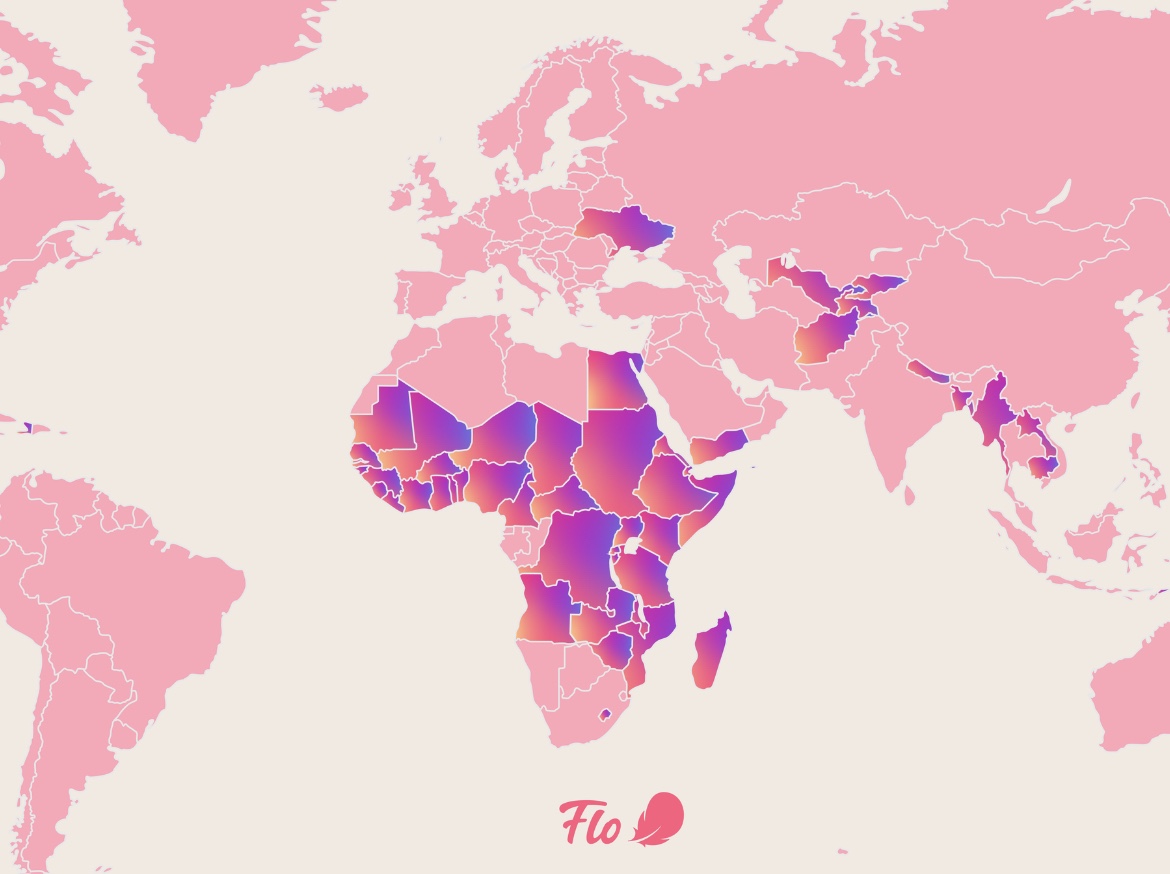Flo, the Leading Health App, Launches Prosocial Initiative Aimed at Improving Menstrual and Reproductive Health Literacy Across 58 Countries

Flo, the #1 leading female health app, has launched a multi-year prosocial initiative aimed at improving menstrual and reproductive health literacy across the globe. With this effort, Flo will grant access to its subscription membership, Flo Premium, including extended product and content features, to women in 58 countries that need it most for free. The countries were selected based on health literacy and health satisfaction rates data from the World Health Organization (WHO), GDP per capita rankings from the World Bank and other metrics.
Starting today, Flo will grant access to Flo Premium to millions of women in 21 countries such as Ethiopia, Cameroon, Haiti, Gabon and many more. Flo will continue granting access to Flo Premium, worth over half a million dollars, to 37 additional countries over the next year.
WHO defines health literacy as an individual’s ability to adequately comprehend health information and to implement this knowledge into their everyday life in order to “maintain or improve quality of life.” Low health literacy is a direct contributor to the spread of misinformation and leads to poor health outcomes and unhealthy behaviors, especially in the areas of menstruation, sexual, and pregnancy health.
Existing research conducted in the countries included in Flo’s prosocial initiative points towards a dramatically low level of menstrual health literacy and the dangers it may pose. In Kenya, research found that only 12% of girls felt comfortable discussing period management with their mothers, while 1 in 4 did not associate menstruation with pregnancy. According to research by UNICEF and WaterAid, only 32% of girls in Bangladesh, 66% in Egypt and 18% in Malawi, were aware of menstruation before their first period. In Egypt, 74% of girls who were unaware felt shocked, afraid or cried during the first occurrence. Similarly, in Bangladesh, 69% felt scared.
Access to medically credible information is imperative for women and people who menstruate because it helps them to better understand their bodies, destigmatizes taboo topics related to their health (e.g periods, menopause, STIs, etc.), and improves their health literacy. Flo provides curated cycle and ovulation tracking, period predictions, proactive health chatbots and personalized health insights, developed by health experts and scientists. According to a Flo research study of over 2,000 users, 89% of them reported that their knowledge about the menstrual cycle has improved, and 72.2% of women said that Flo has helped them feel the most informed about their cycle and pregnancy health. The study also found that users who subscribed to Flo Premium and used it regularly were more likely to report improvements in knowledge and health in all areas they chose to use the app for and even beyond.
“At Flo, we’re building a better future for female health by helping women harness the power of their body signals,” said Cath Everett, VP of Product and Content. “This is without a doubt one of the most important initiatives Flo has ever undertaken. When it comes to health, knowledge is power. We already know that Flo Premium improves attitudes towards health literacy among its users, so we believe that granting free access to Flo Premium can drive real-world impact on health literacy rates at scale. By offering Flo Premium to those who need it most, we hope to empower women and people who menstruate across the globe to better understand their bodies, advocate for their unique health needs and subsequently become the change makers in their respective countries.”
In tandem, Flo will launch a dedicated research study to assess how the use of Flo Premium improves menstrual health literacy and contributes to overall health and wellbeing. The research will also aim to shed light on disparities in health literacy and menstrual cycle stigma in these countries. See the full list of countries included in the initiative here.
In March 2022, Flo made its Premium subscription free for all Ukrainians in order to provide trusted health information and support during a time of overwhelming stress. Since then, over 1.2M Ukrainian users have activated their subscriptions, unlocking Flo’s full suite of health information and resources. Rachel McConnell, Director of User Experience, commented: “We saw an overwhelming response when we rolled out free Flo Premium in Ukraine. Our community really welcomed this initiative, highlighting the importance of enabling access to trusted medical information in regions where it is acutely needed. That’s exactly what we aim to achieve with our new prosocial initiative, making medically credible information easily available to those who need it the most.”






